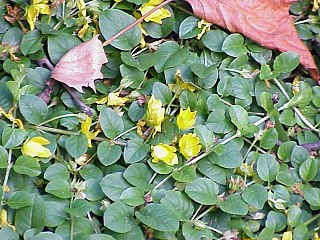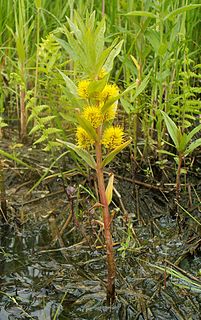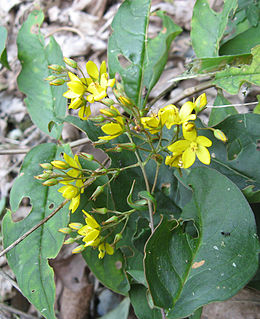Yellow loosestrife is a common name for several plants in the genus Lysimachia and may refer to:
- Lysimachia × commixta, native to eastern North America
- Lysimachia punctata
- Lysimachia vulgaris , native to Europe
Yellow loosestrife is a common name for several plants in the genus Lysimachia and may refer to:

Lysimachia is a genus consisting of 193 accepted species of flowering plants traditionally classified in the family Primulaceae. Based on a molecular phylogenetic study it was transferred to the family Myrsinaceae, before this family was later merged into the Primulaceae.
Loosestrife is a common name for plants within two different genera:

White spruce is a common name for several species of spruce (Picea) and may refer to:
Moneywort is a common name for several plants and may refer to:
Starflower or star flower may refer to:

Lysimachia nummularia is a species of flowering plant in the primrose family Primulaceae. Its common names include moneywort, creeping jenny, herb twopence and twopenny grass.

Lysimachia maritima is a plant species belonging to the family Primulaceae. It was previously called Glaux maritima, the only species in the monotypic genus Glaux. The species has a number of common names, including sea milkwort, sea milkweed, and black saltwort.
Crosswort is a common name for several species of plants and may refer to:
Yellow pimpernel is a common name for several plants and may refer to:

Lysimachia thyrsiflora, the tufted loosestrife, is a plant in the genus Lysimachia. It is native to large sections of the northern Northern Hemisphere, including Eurasia and North America. It often grows in marshes, shorelines of lakes and ponds and occasionally along streams. It is an erect perennial herb growing up to 80 centimeters tall and bearing yellow flowers, sometimes dotted with purple. It may be confused with purple loosestrife when not blooming but can be easily distinguished because purple loosestrife has a square stem. Tufted loosestrife has been used medicinally in Asia to combat high blood pressure.

Lysimachia ciliata, the fringed loosestrife, is a species of flowering plant in the family Primulaceae. It is an erect herbaceous perennial growing to 120 cm (47 in) tall and 60 cm (24 in) broad, with opposite, simple leaves, and smooth green stems. The star-shaped yellow flowers are borne in midsummer. It is native to North America, including most of southern Canada and most of the United States except for the southwest. This plant is notable in that it is one of the few species of Lysimachia to bear elaiophores, that is, to offer oil instead of nectar as a reward to pollinators.

Lysimachia fraseri is a rare species of flowering plant in the primrose family known by the common name Fraser's yellow loosestrife. It is native to the Southeastern United States, where it is listed as an endangered species in several states.

Lysimachia daphnoides is a rare species of flowering plant in the Primulaceae known by several common names, including Pacific loosestrife, lehua makanoe, kolekole lehua, and kolokolo kuahiwi. It is endemic to Hawaii, where there are only three populations remaining on the island of Kauai. It was federally listed as an endangered species of the United States in 2010.

Lysimachia iniki is a rare species of flowering plant in the family Primulaceae known by the common names Wailua River yellow loosestrife and Wailua River island-loosestrife. It is endemic to Hawaii, where there is only one known occurrence existing on the island of Kauai. The plant was federally listed as an endangered species of the United States in 2010.
Lysimachia lydgatei is a rare species of flowering plant in the family Primulaceae known by the common name Maui yellow loosestrife. It is endemic to Hawaii, where there are only four occurrences remaining on the island of Maui, the total number of plants under 300. It is federally listed as an endangered species of the United States.

Lysimachia foemina is commonly known as blue pimpernel or poor man's weatherglass, and was formerly called Anagallis foemina. It is a low-growing annual herbaceous plant in the genus Lysimachia of the family Primulaceae. In a comparison of DNA sequences, L. foemina was shown to be most closely related to L. monelli. It had been thought by many to be closest to L. arvensis, and some authors had even included L. foemina as a subspecies of L. arvensis, as Anagallis arvensis subsp foemina. These three species were among several transferred from Anagallis to Lysimachia in a 2009 paper.
Swamp candle is the common name for two different plant species:
Wailua River yellow loosestrife is a common name for two very rare species of Hawaiian plants and may refer to:
Lowland loosestrife is a common name for several plants and may refer to:
Lysimachia is a genus of flowering plants.